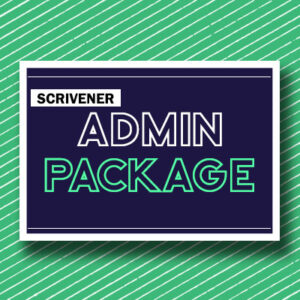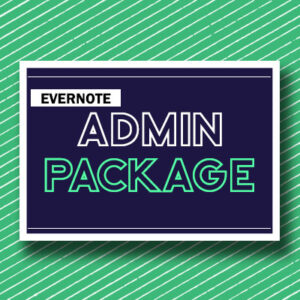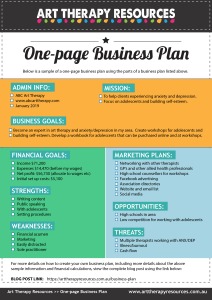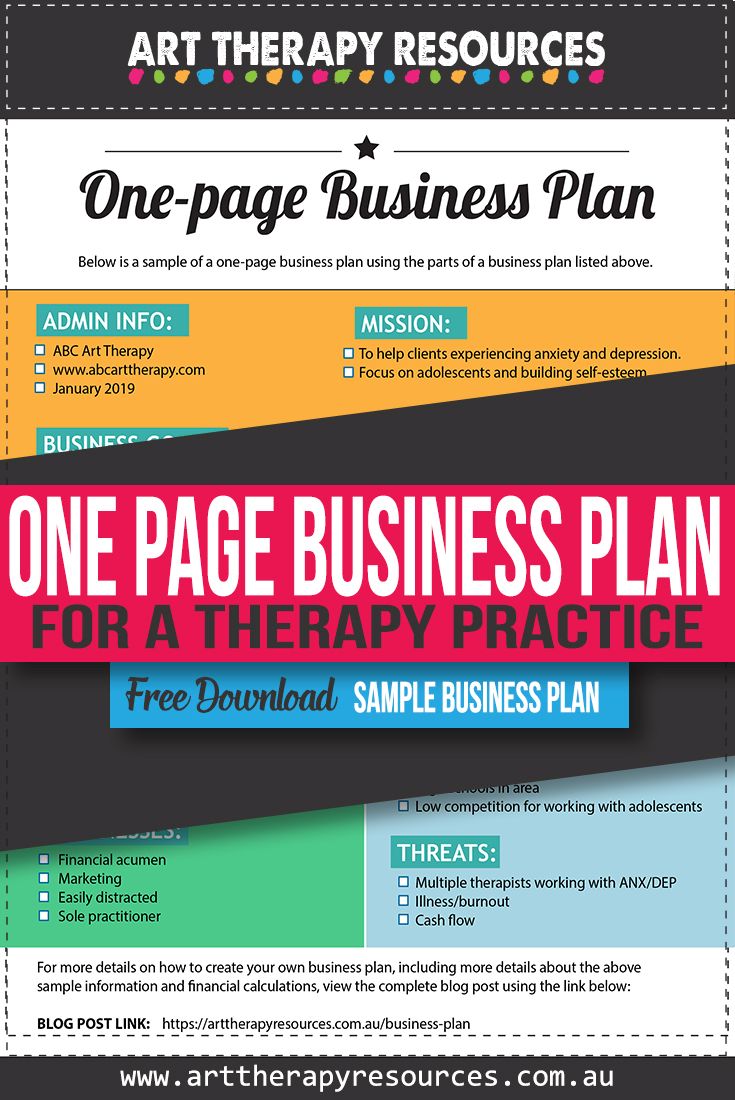THIS POST INCLUDES:
1. Keep Your Business Plan Simple
2. Parts of a Business Plan
3. How to Complete a Business Plan
4. Sample Business Plan: Art Therapy Practice
5. Additional Business Planning Information
6. Free Download Business Plan Checklist
KEEP YOUR BUSINESS PLAN SIMPLE
Many people have a perception of what a business plan entails. They may think business plans are only useful for large companies or businesses you want to get a loan from a bank and need to explain their financial position.
A business plan involves much more than looking at the financial aspects of your business. It involves defining your clients, assessing your strengths and weaknesses in your business, and identifying the resources you need to execute your goals for your business.
Your business plan should be written using simple language. A business plan should be written so that it encourages you to take action on developing parts of your business that need your attention such as resourcing, marketing, and financial planning.
Many business plans are written for the benefit of a board of directors, however, if you are a private practice therapist, your board of directors is you. Therefore it is important to write your business plan using language that will motivate you and help you solve problems that may exist in your private practice.
If you are running a private practice and you are the sole employee, it is easy enough to create a business plan using a one-page process. While it is important to undertake these important administrative and planning aspects of your business, it’s also important that you keep momentum on running your business so that you don’t get too distracted by onerous administrative tasks.
It’s also important to remember that a business plan is often a changing process. As your private practice develops, you may want to change parts of your business that suit your goals at that time.
It’s a good idea to review your business plan at least once a year so that you can make any amendments and future goals for the year ahead. In the first year of your business, you will want to pay close attention to your business plan and possibly review it every month, however, once your practice is established you can undertake a review process less frequently.
A business plan is simply about being prepared.
PARTS OF A BUSINESS PLAN
The content of your business plan should always be based on providing information that helps you progress in your private practice. It is good to include information that is simple, concise and provides actionable steps.
GENERAL BUSINESS PLAN
Essentially, the most important parts of your business plan will include:
- Why do you want to start a private practice
- What are the mechanics of your private practice – income, expenses, staff, administration etc
- What are your strengths, weaknesses, opportunities, and threats (SWOT analysis)
- What is your marketing plan
These 4 areas are fundamental parts of your business plan. Your business plan should be specific to your private practice, however, we’ve created a sample outline below of the most important details that you should consider based on the above 4 fundamental parts.
DETAILED BUSINESS PLAN
- Private practice name:
- Website:
- Date of this plan:
- My mission for my private practice:
- My business goals (should be specific and measurable):
- Income avenues:
- Expenses:
- Initial cost set up:
- My strengths:
- My weakness (and how to manage them):
- Opportunities for my private practice:
- Threats to my private practice succeeding:
- Marketing Plans:
HOW TO COMPLETE A BUSINESS PLAN
Completing a business plan takes some time and effort. Essentially you are working on a document that is based on goals, expectations, and unknowns. It can feel difficult to determine exact details to include in your business plan when there are so many unknown variables.
From this perspective, your business plan is simply a guideline to get you started. It should always be viewed as a process that requires adaptability and flexibility as you become more experienced in running your private practice.
The business planning process can be overwhelming especially if you are more interested in client work instead of administrative work. In many ways creating your business plan is an introduction to running your private practice.
At times when running your private practice, you will be required to do administrative work that feels more tedious compared to the client work that you want to do. It is good to note any resistance you feel when creating your business plan as it may be a good way to assess your desire to run your private practice with many of the non-client work tasks that you will be required to undertake.
Set a time limit on creating your business plan. We’ve introduced 13 sections above in the detailed business plan. You could dedicate an individual time slot for each detailed item so that you don’t get too overwhelmed with researching a lot of information at once.
The first 3 items are simple information recording items and should only take you seconds to record. If you haven’t already named your business or subsequent website name, then you may want to spend some time on working out what your private practice should be called.
Whenever you name anything whether it be your private practice, services types, products, or workshops, you should always name items from your client’s point of view. Any names should be easy to spell, pronounce, remember, and understand in terms of purpose. Consider the demographics of your ideal clients and be guided by what language and words might mean to them. For example, if you want to appeal to elderly clients, you may not want to name your business: Artz4U
As you work through each item on your detailed business plan, remember to record all information in one central area. A lot of software integrates, so you should be able to combine both word processing documents and spreadsheet documents in one primary document. A program such as Evernote is a good tool to use for creating your business plan because you can access it at any time across multiple devices. Evernote is fairly robust in creating written text, tables, checklists, audio, and more.
Evernote is a useful program to record all of your business information in as a central database. This means you can access information about your private practice at any time. Evernote is also a great way to store and record information from external sources (eg. Internet) that you can use to help develop your business.
You may want to read our previous post about using Evernote for blogging to see how you can also use Evernote for your business planning process. 10 Useful Tips to Use Evernote for Blogging
Evernote is free for a basic account, however, you can purchase a premium subscription for additional features. You will easily be able to use a free Evernote account to create your business plan.
SAMPLE BUSINESS PLAN: ART THERAPY PRACTICE
Included in this section is a sample of how to create your business plan using the parts of a business plan listed above. This sample is simplified to give you an idea of how each section should be used.
It’s important to note that your financial information such as income, expenses, and initial set up are usually specific to your first year. Each additional year after will be different as you may not have the same ongoing costs as you did in your first year. You will also most likely have your lowest income year in your first year until your practice becomes more established.
It is is a good idea to extrapolate your financial calculations out for at least the first 5 years so you can get some perspective over the short and long term success of your private practice. This will also help you plan for any initial savings that you need to inject into your business in the first year. Being financially prepared will help reduce the stress that you feel around meeting income goals.
The more elaborate your business goals are, the bigger your business plan will be. This business plan is a simplified version to get you moving and taking action on establishing your private practice.
All names, websites, and financial information is fictional for illustration.
PRIVATE PRACTICE NAME
ABC Art Therapy
WEBSITE
www.abcarttherapy.com
DATE OF THIS PLAN
January 2019
MY PRIVATE PRACTICE MISSION
To help clients experiencing anxiety and depression. A focus on adolescents and building self-esteem.
MY BUSINESS GOALS
- Become an expert in art therapy and anxiety/depression in my area.
- Create workshops for adolescents and building self-esteem
- Develop a workbook for adolescents that can be purchased online and at workshops
INCOME GOALS (per year)
- General client sessions – 4 clients per day x 4 days x 50 weeks x $80 per session = $64,000
- Workshops – 4 per year x 10 clients each x $80 = $3200
- Workbook – $20 x 200 sales per year = $4000
TOTAL INCOME YEAR 1: $71,200
NOTE: Your income will most likely be more varied as you may choose to take on reduced fee clients or charge more for additional services such as report writing etc. You may also set initial client session goals for the first year and increase them each year after.
EXPENSES (ongoing per year)
- Rent $7800
- Bank Fees $100
- Accounting/Legal $200
- Education/Courses $300
- Telephone/Internet $500
- Insurance $320
- Office Supplies $800
- Art supplies $2500
- Professional fees $150
- Repairs and maintenance $150
- Subscriptions $150
- Advertising $1500
- Wages (inc. Tax, superannuation/401k, retirement) TBA
TOTAL EXPENSES: $14,470
NET PROFIT: $71,200 – $14,470 = $56,730 (allocated to wages, taxes, retirement planning etc)
NOTE: In the expenses section, we’ve written TBA under Wages etc. You may want to calculate the wages you pay yourself as a set amount at the start and then your income and expenses will need to allow for that level of wages to be paid. Alternatively, you may want to calculate your income and expenses initially, and then allocate the remaining profit to pay your wages.
INITIAL COST SET UP
- Plastic desks x 5 $100
- Plastic folding chairs x 10 $100
- Lounge chairs x 3 $500
- Art room decor $200
- iPad $1200
- Desktop computer $1200
- Printer/scanner $300
- Art room supplies $1000
- Website and general admin $500
TOTAL SET UP COST: $5,100
STRENGTHS
- Writing content – good for creating workshops and workbooks
- Public speaking – good for public marketing and networking
- Specialty in working with adolescents (note various training obtained)
- Setting procedures
WEAKNESSES
- Financial acumen – need to hire a bookkeeper/accountant. Set a schedule for reviewing data
- Marketing – undertake a free online course to determine the best methods of marketing online and offline
- Easily distracted – can become distracted by pursuing multiple goals. Set a plan and meet with an accountability partner to stay on track
- I am a sole practitioner – investigate income insurance
OPPORTUNITIES FOR MY PRIVATE PRACTICE
- There are 3 high schools in my immediate area where I could offer my workshops or work with the school counselor on developing programs.
- There are only 2 other therapists who deal specifically with adolescents in my area – neither of them provides art therapy services.
THREATS TO MY PRIVATE PRACTICE SUCCEEDING
- There are 8 other therapists who focus on anxiety/depression treatments. Approach each of them to network for referrals.
- Illness and professional burnout – implement regular self-care and supervision
- Cash flow problems – develop a nest egg to pay bills
MARKETING PLANS
- Networking with other therapists in my area
- Contact GP’s and other allied health professionals
- Network with high school counsellors for workshops
- Facebook advertising
- Art therapy association directory
- Counselors association directory
- Build website content and create email list with newsletter
- Social media posting – establish social media plan
ADDITIONAL BUSINESS PLANNING INFORMATION
Below is a list of previous blog posts that will supplement the information about business planning in this blog post. Read these blog posts to dig deeper into each aspect of running your art therapy practice.
ADMINISTRATION
- How to Backup Your Important Business Files
- Practice Management Software to Use as an Art Therapist
- 10 Steps to Set Up Your Art Therapy Practice
ART THERAPY HELP
- How to Set Up Your Art Therapy Room
- Link List: Useful Therapy Resource Websites for Forms, Templates and Tools
FINANCIAL
- Excel (spreadsheets) vs Accounting Software To Record Financial Information
- How to Record Income and Expenses for your Art Therapy Practice
- Strategies to Increase Profit For Your Therapy Practice
- 10 Ways to Increase Your Therapist Income
- How Do I Create an Ecourse for my Therapy Practice
- How To Organise an Art Therapy Group
- What to do when you have no clients booked
- Where to find Clients for your Art Therapy Practice
MARKETING
- 5 Essential Marketing Templates for your Therapy Practice
- Create A Sales Funnel for an Art Therapist
- Design a Simple Layout for Your Art Therapy Website Design
- How to Build an Email List for your Therapy Practice
- How to Create a Free Offer to Build Your Email List
- How to Create an Annual Social Media Plan in 60 mins
- How to Get Started With Google Analytics in 5 Easy Steps
- How to Plan Your Marketing Strategies
- Link List: Online Marketing Courses to Improve Your Marketing Skills
- Review of Free Social Media Schedulers
- The Best Marketing Methods for Art Therapists
- Tools for Organizing Your Social Media Content
- Understand the Marketing Cycle of Your Art Therapy Practice
NETWORKING
PLANNING
- 10 Useful Planning Tools for Your Business
- 10 Useful Tips to Use Evernote for Blogging
- How to Plan A Productive Year as a Therapist
- Planning Template for Your Art Therapy Practice
- Task Management Software For Art Therapy Planning
SELF-CARE
————————
Need help with setting up your Therapy Practice admin policies and procedures?
If you need help to set up your Therapy Practice business, we have an Admin Package in the store which contains a collection of essential business documents.
The Admin Package is available in 3 formats, including:
You can read more about the packages in our store HERE.
  


BUSINESS ADMIN
- Business Details
- Accounts
- Contacts
- Financial Policies
- Fee Schedule
- Cancellation Policy
- Refund Policy
- Legal Policies
- Copyright
- Disclaimers
- Terms of Use
- Privacy Policy
- Business Trackers
- Social Media Tips
- Business Admin Maintenance
- Calendars
BUSINESS DEVELOPMENT
- Business Goals
- Project Template
CLIENT ADMIN
- Client Intake Checklist
- Client Call Log
- Consent for Services
- Client Privacy Policy
- Authorisation to release information
- Social Media Policy
EMAIL & LETTER TEMPLATES
- Inquiry Reply
- Referral Request
- Reminder Late Payment
- Response for psychological report
- Response to subpoena
FREE DOWNLOAD: Free Download Sample Business Plan
SIGN UP below to download the FREE Sample Business Plan to help you create your own business plan for your art therapy practice.

BUILD YOUR ART THERAPY REFERENCE MATERIALS:
Pin this image to your Pinterest board.

SHARE KNOWLEDGE & PASS IT ON:
If you’ve enjoyed this post, please share it on Facebook, Twitter, Pinterest. Thank you!
